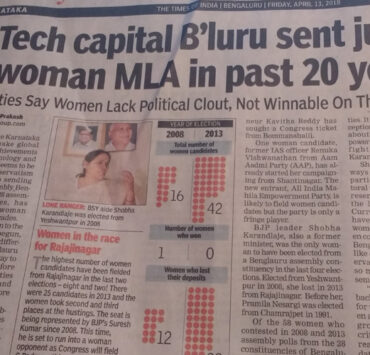
By Preethi Nagaraj
The Election Commission announced today that elections to the Karnataka Legislative Assembly will be held on May 12. In the face of impending elections, the state is standing at the crossroads on many issues. Till now, the question of women’s participation used to make some noise in the public sphere. However, this time, with less than six weeks to go for the upcoming polls, there isn’t even a small mention or discussion on women’s participation anywhere – neither in the media (barring a few exceptions – see below), nor in the political powerhouses.
http://bengaluru.citizenmatters.in/women-mlas-karnataka-bangalore-analysis-23102
This, despite the fact that the state had won accolades for achieving almost 50% participation of women in the Panchayat Raj system. Karnataka has the rare distinction of having been not only the first state to institute Panchayati Raj and to reserve seats for women (before the rest of the country followed suit), but also being one of the first states to achieve the 50% milestone.
I remember writing a story about a first generation displaced tribal woman in a tribal settlement near Periyapatna around Mysore fighting Panchayat elections – and, mind you, in the general category. She had rejected the reserved seat and decided to jump into the open pool. And what an impressive victory she tasted!
Till a decade ago, Karnataka seemed to be on the right track towards sharing the political dias with women. However, according to a recent report, women in the state fared better in the 1950s and 60s than they do now. Did we miss the woods for the trees?
With barely five MLAs in the House and a lone woman minister at present, Karnataka faces an uphill task to ensure women’s representation in politics with more efficiency than it has displayed so far. The seats that seem likely to go to women participants are usually the ones that come from the cushy and most proximate comforts of family politics. The JD(S) is known to have offered tickets to supremo HD Devegowda’s daughters-in-law, Bhavani and Anita. It could only be some sort of an ironic metaphor that although the JD(S) symbol is that of a woman carrying a haystack, the party comprises mostly men, barring a few exceptions.
The Congress and the BJP, the two other major parties in the fray, are currently tight-lipped about their probable candidates and about whether or not there would be any focus at all on increasing women’s participation. Although Congress President Rahul Gandhi did make a recent appeal to improve women participation in the polling process, CM Siddaramaiah candidly admitted that giving party tickets to women was a tough proposition.
Before this government came into power the number of first-time voters stood at 7.18 lakh across the state. This year the number has more than doubled and nearly 15.42 lakh voters will exercise their franchise for the first time in May. The final summary of the electoral roll published by the office of Karnataka’s Chief Election Commissioner reveals that women voters are up 13 per cent. It is unfortunate that, at such an opportune moment, women’s representation in the Assembly and governance is worse than dismal.
At another level, the Election Commission has major plans to increase women’s participation in the polls as voters – with plans to set up all-women booths with women polling officers, women agents and female police to guard these facilities.
The Women’s Reservation Bill – or the Constitution (108th Amendment) Bill, 2008 – that demands reservation of at least 33% of seats in Parliament for women is yet to be considered feasible by political parties. The legislation has been lying dormant for 14 years and there is little sign of hope about the Bill being passed any time soon. Of course, Congress President Rahul Gandhi has made passage of the Bill one of his ‘election promises’ – to be fulfilled if his party comes to power in the general elections scheduled to be held in 2019. A young, female Congress politician, who made a lateral entry into the party cadres – former MP Ramya — has been put in charge of the party’s social media cell. One often wonders what this could be called: is it empowerment or privilege at work?
What is usually held out as an olive branch when the question of women’s representation is brought up is the active participation of women in the Panchayat Raj mechanism. However, what happens after women who make it into grassroots politics complete their term in their villages? Why do we not see them encouraged to grow and enter politics at other levels, at least some eventually becoming full-fledged leaders? Is it the almost patriarchal set-up of politics that stands in their way?
The coming election is crucial for politics in Karnataka. The BJP has been casting its net far and wide. The state is the lone and currently the only large citadel with a Congress government. Political strategists see this election as one that will determine not only the survival of the Congress in this state, but also the possibility of its resurrection across the country. Under the circumstances, the fond hopes for increased representation for women may remain mere dreams, with the Congress adopting a strategy that will allow only the most winnable candidates into the fray, without considering the need to balance the gender equation.
The JD(S) and the BJP do not seem to be very different in this respect. Among the ticket aspirants in the BJP, the very few names of women politicians that spring up are Shakuntala Shetty, Shobha Karandlaje and Malavika Avinash, at least at this stage. The parties are yet to draw up their lists of candidates in this closely pitched match. But whenever electoral politics becomes a boxing ring, with political parties holding their cards close to their chests, women’s empowerment is bound to take a beating. This time, too, it is not going to be any different.




